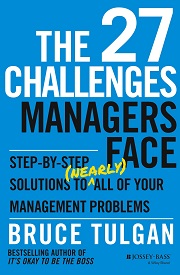What We're Reading Now
Practical Help for Managers and Their Stickiest Situations
20 January 2015
Allison read The 27 Challenges Managers Face: Step-by-Step Solutions to (Nearly) All of Your Management Problems and was delighted with Bruce Tulgan’s latest installment of practical advice for supervisors.
Tags: allison read, bruce tulgan, management and supervision
We’re big fans of Bruce Tulgan’s work at Allison Partners. We know that study after study shows that one of the single most important drivers of employee engagement (if not the most important driver) is the employee’s relationship with his or supervisor. We spend a lot of our time helping managers learn how to supervise since more often than not they haven’t been taught this critical workplace skill. And whether it’s in our course, The Art of Being a Great Boss, or in our one-on-one conversations with managers, dealing with tough, sticky situations is the stuff people really want help with.
To get the most out of Tulgan’s newest book you need to start by reading It's Okay to Be the Boss: The Step-by-Step Guide to Becoming the Manager Your Employees Need. He explains how all the talk of avoiding micromanagement is covering up the real crisis in the workplace… undermanagement. He provides a Management 101 framework that takes you through the steps to becoming the boss your employees need (and want).
The single most important part of Tulgan’s framework is weekly, structured, 15-minute one-on-one meetings with employees scheduled in advance. Every client I’ve worked with balks at this in the beginning, but all who eventually follow the advice become believers and report that it gets them out of the constant firefighting mode they were living in before. These meetings lay the groundwork for managers to deal with the 27 situations that Tulgan writes about in this new book.

You may be wondering how he decided on 27 challenges. As is always the case with Tulgan, it’s based on research his company has done. At Rainmaker Thinking, Inc. they’ve “…asked hundreds of thousands of managers… ‘which employee situations are the most challenging for you as a manager?’… more than 90 percent of the responses over the years refer to these same 27 challenges.” When I think back over the situations I helped individual managers deal with in 2014, almost every one of them is covered in Tulgan’s book. Here are the most common ones I helped with last year:
- Challenge #2 When Going from Peer to Leader
- Challenge #5 When Employees have a Hard Time Managing Time
- Challenge #6 When an Employee Needs Help with Interpersonal Communication
- Challenge #14 When an Employee Needs an Attitude Adjustment
- Challenge #16 When an Employee has Personal Issues at Home
- Challenge #17 When There Is a Superstar You Need to Keep Engaged
- Challenge #22 When Managing Under Resource Constraints
- Challenge #26 When You Need to Renew Your Management Relationship with a Disengaged Employee
I especially like how Tulgan recommends this approach to difficult feedback. He also provides numerous examples of how to address the 27 challenges using these three steps:
- Describe the problematic behavior
- Explain the impact on work
- Spell out the behavior you want to see instead
When managers are dealing with a new problem behavior, I think it’s appropriate to do one and two first and then see how the employee wants to change the behavior before being as prescriptive as number three recommends. However, once a manager has talked about a problem two times and is moving onto a third conversation, then being ready with examples for Tulgan’s number three, “Spell out the behavior you want to see instead,” is a good idea.
In my 2011 blog post about It’s Okay to Be the Boss, my one criticism was that, “…Tulgan could use some work on how he phrases feedback. In an effort to be straightforward and constructive, I find his tone in many of his examples to seem a bit harsh and condescending.” As a new blogger, I was pretty excited when Tulgan commented on my post and acknowledged that this was something he was trying to fine tune in his seminars.
I’m happy to report that I see this fine tuning in many of the examples that Tulgan includes in this newest book. His approach is still straightforward which I actually agree with since too often managers try to cushion the blow and be kind in ways that just muddle the message and make things much worse. However, I like how he’s softened some of the edges of his feedback and provided more detailed scripts for managers to follow. Additionally, he provides detailed advice about how to diagnose problems with an employee and set up plans for improvement.
Finally, if you want to improve your overall life as a manager, check out my post about Tulgan's book It's Okay to Manage Your Boss: The Step-by-Step Program for Making the Best of Your Most Important Relationship at Work. I'll be letting my clients know that all three of these books can help them to feel more satisfied with their relationships at work and that's what I find everyone is craving.







Comments
Our Comment Policy:
Our blog posts are only half of the conversation. What our readers have to say is equally important to us, and we're grateful for all the comments that continue the dialog.
To ensure that the discussion here is as useful as possible to all of our readers, please be respectful of our contributors and refrain from harassing, threatening and/or vulgar language. We reserve the right to screen and remove any comments from the site. If you have a question about a comment or want to discuss our policy, please contact us. We'll talk it over.
There are no comments for this entry yet.